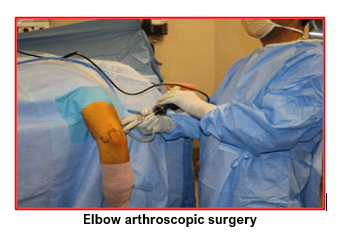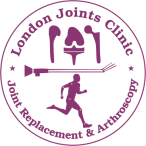Elbow Arthritis and
Elbow Joint Replacement
Elbow arthritis is a condition wherein the smooth articular cartilage lining the articulating surfaces of the bones forming the elbow joint gets worn out. This leads to rubbing of the worn surfaces, pain and limitation of elbow movements.

Elbow Arthritis can be caused due to:
Osteo-arthritis – age related wear and tear of the articular cartilage
Rheumatoid arthritis – autoimmune inflammatory disease disorder
Post-traumatic arthritis – secondary to articular fractures, malunited fractures around the elbow, elbow dislocations, chronic elbow instability
Post-infective elbow arthritis.
Patients with elbow arthritis may complaint of:
- Pain on moving the elbow joint.
- Swelling and deformity of the elbow
- Difficulty in bending or straightening the elbow
- Inability to carry or hold objects in the affected hand
- Grating or locking sensation in the elbow
- In later stages, tingling and numbness along the inner border of the hand
Elbow arthritis is diagnosed based on patient’s typical symptoms, his medical history, thorough clinical examination and x-rays of the elbow.
CT scans and MRI scans of the elbow are not routinely needed for diagnosis. Blood tests may be needed for confirming inflammatory arthritis.
Elbow arthritis can be treated based on patient’s symptoms, stage of his elbow arthritis and functional difficulties.
The treatment may be conservative or surgical.
All patients are given conservative treatment in the initial stages.
This involves:
- Activity modifications – patients are educated about their disease and taught lifestyle modifications to reduce their pain and keep it under control. Pain inducing activities like lifting, pushing, pulling are avoided. Patients can learn to lead an active lifestyle with some minor changes to their routine activities.
- Anti-inflammatory and Pain-killer medications – these help in controlling pain and reducing inflammation. This results in improved mobility. There are various types of medications available for pain control. These medications are prescribed taking into account the patient’s pain intensity, health profile and his safety. All such medications must be taken as per doctor’s advice and instructions.
- Physiotherapy – helps in strengthening the muscles around the elbow joint. This helps in reducing pain, improving range of motion and improved elbow function. Regular exercise does not worsen the arthritis.
- Chondro-protective agents – Glucosamine and chondroitin sulphate are considered as chondro-protective medications. These slow down the process of arthritis and thought to help in regrowth of the cartilage. This helps in pain relief. These medications need to be taken together in appropriate doses for best possible result.
- Visco-supplementation – This involves injecting the elbow joint with special liquids (hyaluronic acid) that increase the viscosity of the joint fluid and improve the health of the elbow cartilage. This leads to improved joint lubrication and reduced friction between the arthritic surfaces of the elbow joint. Minor cartilage lesions are thought to heal with such injections. Their pain-relieving effect lasts for 6 months to 12 months. Ideally most useful for early stages (mild to moderate) elbow arthritis in young patients. Based on their viscosity these injections can be a single dose or multiple dose therapy.
- Cortico-steroid injections – help in reducing pain, inflammation and swelling in arthritic elbow, especially due to rheumatoid arthritis or osteo-arthritis. Multiple injections must be avoided for the risk of infection in the elbow joint.
Surgical treatment:
These options are offered to patients not responding to conservative treatment or in whom it has stopped giving lasting relief.
Arthroscopic Elbow joint debridement – this is a minimally invasive surgery done through tiny incisions. Useful for early to moderate stages of arthritis.
The joint surfaces are inspected, loose cartilage flaps get removed and the areas smoothened out. Any inflamed and thickened joint lining (synovium) gets removed and the joint is washed out. This is done as a day-care or one day stay surgery. Patient are put of physiotherapy regime after surgery.
Elbow Joint Replacement is a surgical procedure in which worn out joint surfaces of the elbow joint are replaced with prosthetic implants.
This surgery is performed for patients having:
- Advanced stage elbow arthritis and who are not responding to conservative treatments.
- Patients having rheumatoid arthritis with advanced stage elbow arthritis
- Severe fractures in osteoporotic bones in the elbow region in elderly patients
- Tumours or growth in the elbow joint
- History of previous elbow surgery and deformity

The goal of elbow joint replacement surgery is to eliminate pain and increase the mobility of the elbow joint.
This surgery is performed under sterile conditions in an operating room under general or regional anaesthesia and involves the following steps:
- An incision is made over the back of the elbow.
- The muscles are retracted, and tendons and ligaments are moved away to expose the elbow joint. Care is taken to protect and move the ulnar nerve to prevent nerve damage.
- The damaged joint surfaces of the humerus, radius and ulna are cut off with a surgical saw to create a smooth surface to receive the prosthetic implants. Generally, only the humeral and ulnar implants are used for elbow replacement. There is no need to replace the excised radial head.
- A special instrument is used to hollow out the inside of the humerus bone to insert the humeral component of the prosthesis.
- Once a proper fit is established, the surgeon repeats this procedure on the ulna bone to prepare it for the ulnar component of the prosthesis.

- The humerus and ulna bones are then prepared with or without cement, depending on the patient’s bone strength and surgeon’s preference. In elderly patients with osteoporotic bones, there is need for bone cement and cemented implants. In younger patients and those with strong bones, the surgeon uses specially coated uncemented implants.
- The components are then inserted and put together ensuring proper movement of the hinge portion of the prosthesis.
- With all the new components in place, the joint is tested through its range of motion.
- The surgeon then irrigates the new joint with sterile saline.
- The surgeon then sutures the joint capsule together, repairs the muscles and tendons and sutures the skin after keeping a drain in place to help drain out any blood from the surgical area.
- The elbow is then covered with a sterile dressing and compression bandage is applied
- The arm is placed in a shoulder sling.
- Patient is sent to the recovery room for observation
The patient’s expected progress after elbow replacement surgery is as follows:
- Patients can start eating and drinking after 3-4 hours
- Regular icepacks are used 4 to 5 times a day
- The operated arm remains in a sling. Pillows are used to keep elbow elevated and above level of heart. This helps in reducing pain and swelling
- Intravenous antibiotics are given for first 24 hours only.
- The suction drain gets removed after 24 hours & wound dressings are changed.
- Physiotherapy is started soon after surgery. It is continued for 3 months to help regain full elbow range of motion.
- Patient stays in the hospital for 2 to 3 days after the surgery.
- Wound gets inspected and the sutures are removed at 12 to 14 days post- surgery.
- Patients are instructed to keep the wound dry. Bathing and showering are generally allowed after wound healing and suture removal around 14 days post-surgery.
- Patients are given specific instructions about do’s and don’ts and advised to carry on physiotherapy under supervision.
- They are encouraged to eat a healthy diet and stop smoking to promote healing.
Most patients suffer no complications following Elbow Joint Replacement. However, complications can occur following elbow surgery and include:
- Swelling
- Infection
- Fractures of the humerus or ulna bone
- Dislocation of the elbow
- Damage to nerves or blood vessels
- Blood clots (Deep Venous Thrombosis)
- Elbow stiffness
- Loosening of implants
- Wound irritation and scar tenderness
- Failure to relieve pain
Book An Appointment
Private Clinics : Locations & Directions
London Joints Clinic (Pune)
Address
Office S 5, 2nd Floor, North Block, Sacred World Mall,
Opp Sacred Heart Township, Near Jagtap Chowk,
Wanawadi, Pune 411040
Monday to Saturday
6 PM to 9 PM
Appointments
Hospitals OPDs : Locations & Directions
Jupiter Hospital (Baner)

Address
Lane 3, Baner- Balewadi Road,
Prathamesh Park,
Baner, Pune 411 045
Monday to Saturday 11 AM to 4 PM
Appointments
Contact us
Dr Anand Jadhav has a centralised appointment system for all locations across various hospitals and clinics in Pune & PCMC areas
Appointment Bookings & Requests can be made by any method :

